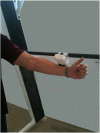Prediction of in-season shoulder injury from preseason testing in division I collegiate football players
- PMID: 25364482
- PMCID: PMC4212351
- DOI: 10.1177/1941738114523239
Prediction of in-season shoulder injury from preseason testing in division I collegiate football players
Abstract
Background: Collegiate football is a high-demand sport in which shoulder injuries are common. Research has described the incidence of these injuries, with little focus on causative factors or injury prevention.
Hypothesis: Football athletes who score lower on preseason strength and functional testing are more likely to sustain an in-season shoulder injury.
Study design: Prospective, cohort study.
Level of evidence: Level 2.
Methods: Twenty-six collegiate football players underwent preseason testing with a rotational profile for shoulder range of motion, isometric strength of the rotator cuff at 90° elevation and external rotation in the 90/90 position, fatigue testing (prone-Y, scaption, and standing cable press), and the Closed Kinetic Chain Upper Extremity Stability Test (CKCUEST). Data collected postseason included the type of shoulder injury and the side injured. Logistic regression was used to determine if the testing measures predicted injury, and a receiver operating characteristic curve was constructed to examine the relationship of CKCUEST to injury.
Results: Six athletes sustained shoulder injuries during the season. Predictor variables could significantly predict whether that player would sustain an injury during the season for both the right and left shoulders (P < 0.05). The variables that were significantly correlated with injury of the right side were forward elevation strength, prone-Y to fatigue, and the CKCUEST (P < 0.05); on the left, only the CKCUEST was significant (P < 0.05). The area under the receiver operating characteristic curve for the CKCUEST was 0.86 (ϵ = 0.87, P = 0.01). Using a score of 21 touches, the CKCUEST had a sensitivity of 0.83, a specificity of 0.79, and an odds ratio of 18.75 in determining whether a player sustained a shoulder injury.
Conclusion: For this sample, the combination of preseason strength, fatigue, and functional testing was able to identify football players who would sustain a shoulder injury during the season.
Clinical relevance: Using a battery of strength, fatigue, and functional testing may be helpful in identifying football players during preseason who are at a higher risk for sustaining a shoulder injury. This information can be used to optimize preseason testing and implementation of injury prevention programs.
Keywords: football; injury prediction; shoulder.
Conflict of interest statement
The authors report no potential conflicts of interest in the development and publication of this article.
Figures






References
-
- Byram IR, Bushnell BD, Dugger K, Charron K, Harrell FE, Jr, Noonan TJ. Preseason shoulder strength measurements in professional baseball pitchers: identifying players at risk for injury. Am J Sports Med. 2010;38:1375-1382 - PubMed
-
- Borg G. Psychophysical bases of perceived exertion. Med Sci Sport Exer. 1982;14:377-381 - PubMed
-
- Donatelli R, Ellenbecker TS, Ekedahl SR, Wilkes JS, Kocher K, Adam J. Assessment of shoulder strength in professional baseball players. J Orthop Sports Phys Ther. 2000;30:544-551 - PubMed
-
- Ebaugh DD, McClure PW, Karduna AR. Scapulothoracic and glenohumeral kinematics following an external rotation fatigue protocol. J Orthop Sports Phys Ther. 2006;36:557-571 - PubMed
LinkOut - more resources
Full Text Sources
Other Literature Sources
Medical
Research Materials

